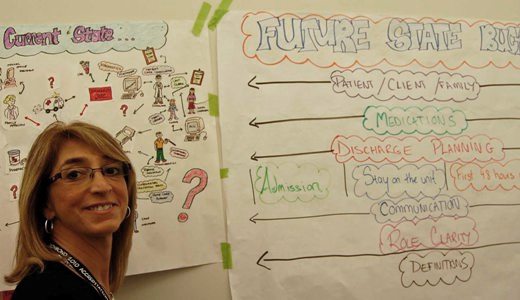Maintaining Momentum: Continuing to focus on quality and patient flow
As you know, quality improvement and patient flow are key priorities for VCH-Richmond. Over the past few months, we have made great strides in a number of areas and experienced significant challenges in a few others.
Achievements
Since early spring, we have seen a steady improvement in the wait times to see an emergency physician, along with a reduction in overall length of stay for patients while in the ED; achievements all the more impressive when you consider that we have also seen a significant increase in visits. A concerted effort from all our care teams has allowed us to transfer admitted patients to inpatient units much more efficiently, in turn, generating an increase in patient satisfaction scores, a reduction in the number of patients leaving without treatment, and a significant increase in pay for performance revenue (to date we have generated $500,000 more than we did by this time last year, and these dollars are being used to reinvest back into care and services for our patients).
I’d like to thank the entire Richmond team for your continued focus on and commitment to maintaining this momentum and building on our successes.
Challenges
One area where we continue to face challenges, however, is with the number of ALC (Alternate Level of Care) patients awaiting transfer to residential care (on average, there are about 25-30 ALC patients in acute care beds on any given day). A significant contributing factor is the lack of residential care beds available in Richmond. We are exploring all options to address this need until a longer term, VCH-wide strategy is in place, likely within the next two years.
This fall, teams in community and residential will continue to focus on a number of key initiatives aimed at improving time to care for patients, improving quality outcomes, and supporting safe patient transition from acute care to home and community.
Introducing Two New Initiatives
As an organization committed to continuous improvement and learning, we will also seek innovative ways to respond to ongoing challenges. For example, this fall we will introduce two new initiatives in acute care intended to further improve patient flow and quality outcomes – the Diagnostic and Treatment Unit (DTU) and Community Liaison pilot.
- Diagnostic and Treatment Unit – The DTU, to be located in the current SSU space, will be home to ED patients requiring observation for less than 24 hours who meet criteria for a specific care pathway.
- Community Liaison Pilot – The Community Liaison pilot will see a community nurse actively involved in discharge planning on 4 North in order to create early linkages with community supports and ensure safer and earlier transitions to home.
Evaluation measures will include improvement in wait times, reduction in overall length of stay, and decreased readmission rates. Rich Dillon will lead the DTU pilot, while Jennifer Kennedy and Ashifa Ahmed will lead the Community Liaison pilot. Teams will be involved in planning over the coming weeks.
Other ongoing patient flow strategies will continue over the coming months, including moving to the next phase of BestPath, increasing the number of care spaces on inpatient units, performing long length of stay and ALC “deep dives” to identify and resolve key issues and roadblocks, and finalizing surge protocols.
We will continue to support current programs, processes and activities, and while doing so evaluate the impact on improving patient flow and promoting safe discharge. By December, we plan to reach consensus on a patient flow model for Richmond CoC that is patient centred, evidence based and outcome driven.
Should you have ideas you would like to share related to improving access to care, please don’t hesitate to connect with your manager, supervisor, director or me.

